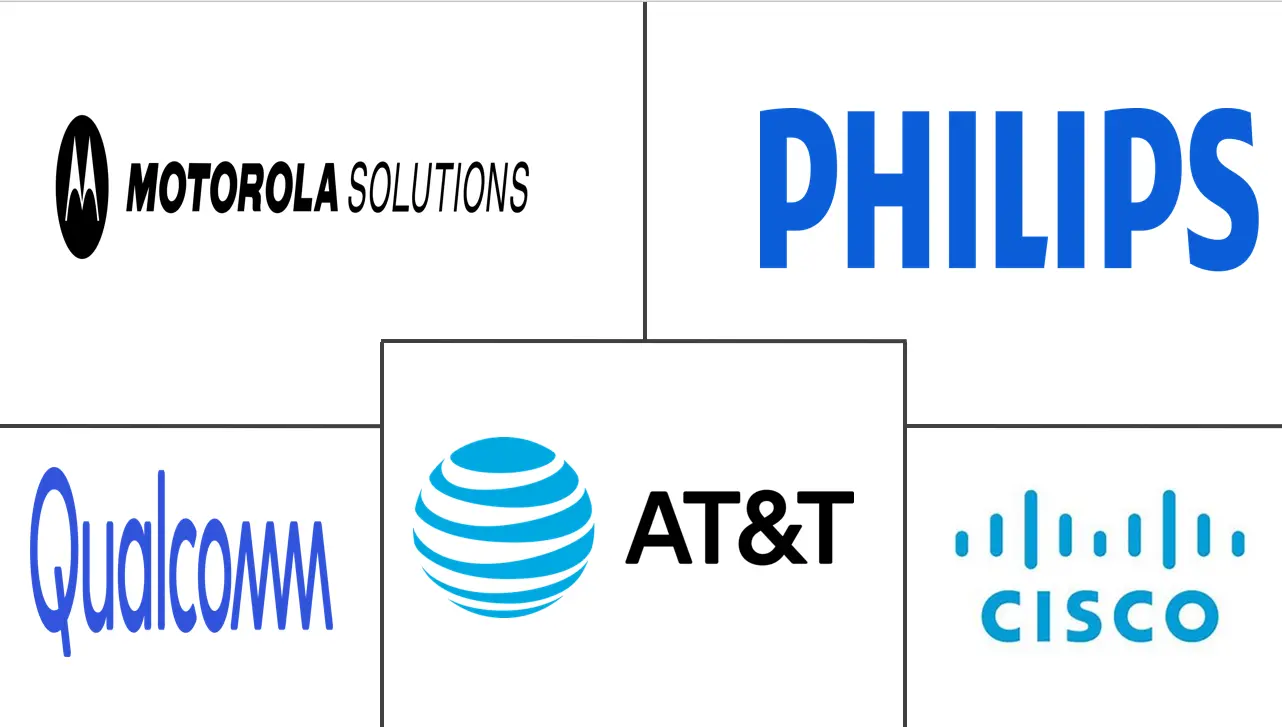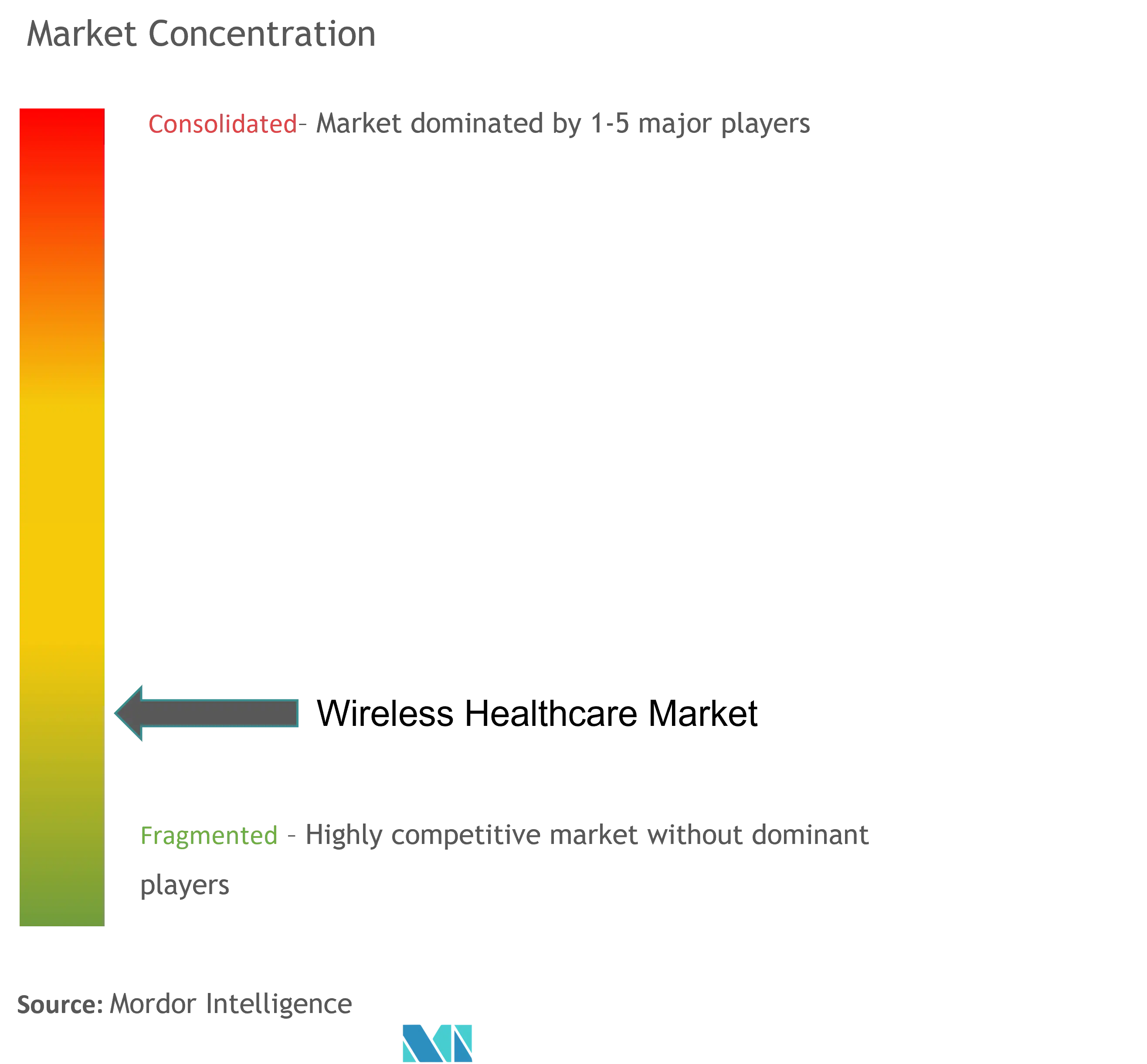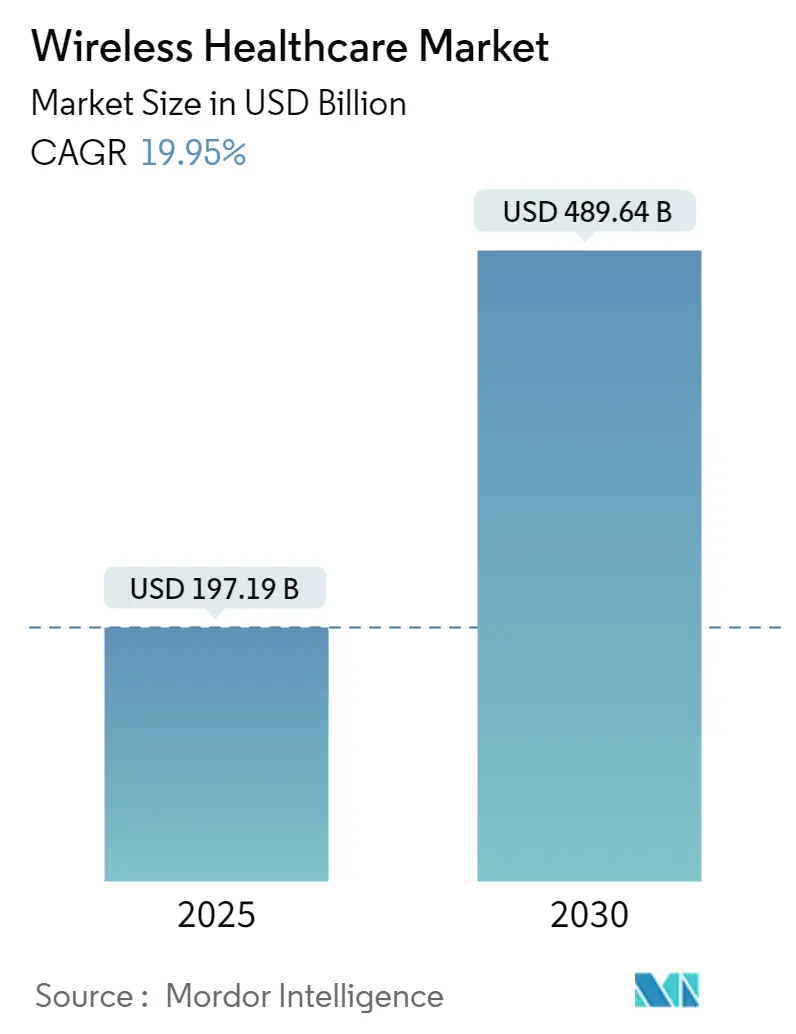
Wireless Healthcare Market Analysis
The Wireless Healthcare Market size is estimated at USD 197.19 billion in 2025, and is expected to reach USD 489.64 billion by 2030, at a CAGR of 19.95% during the forecast period (2025-2030).
The wireless healthcare market is major driven by increasing digitization, growth in the use of connected devices, advancements in wireless technology, and rising adoption of patient-centric approaches by healthcare organizations coupled with growing demand for quality healthcare.
- The healthcare sector worldwide has rapidly undergone a significant digital transformation over the past few years. The penetration of the internet and wireless communication technology is driving the market studied. In a connected hospital, caregivers use wireless medical equipment to provide patients with quality care rather than being preoccupied with time-consuming administrative tasks. Doctors and nurses can easily access up-to-date patient information, enabling treatment decisions supported by real-time medical information, thus, resulting in improved outcomes for patients.
- Wearable devices for continuous monitoring are driving the market. Owing to the proliferation of smartphones and the acceptance of wearable devices, medical devices and diagnostic centres are experimenting with body-worn sensors that can monitor vital signs and transmit them in real time to an online platform that can be remotely accessed.
- Further, the adoption of wearable devices in this sector has been gaining traction in recent times, which, in turn, has been one of the significant factors influencing the wireless healthcare market. The major trends in wearable connected devices include increasing demand for pain management wearable devices, increasing use of wearables for cardiovascular disease management, and others.
- Moreover, the growing demand for remote patient monitoring solutions due to the aging population and long-term chronic disease conditions is the major factor impacting the market's growth. There is constant pressure on hospital administrators to lower costs while continuing to improve the level of patient care. In this environment, hospitals use wireless technologies to operate more efficiently, support patient care, and improve their experience.
- For instance, to better understand and improve the workflow of nursing staff, hospitals are equipping nurse ID badges with an RFID tag that works with the hospital's Wi-Fi network. These tags track the movement of the nurses throughout their shifts. The data is captured and analyzed, providing insights to the hospital to improve the processes. Wireless RFID technology also allows hospitals to track the real-time location of critical equipment and the condition of the equipment.
- However, issues about cybersecurity and privacy are restraining the market growth, as vast amounts of healthcare data are generated during treatment in medical centers, such as hospitals and clinics, and the theft of such data can damage patients' privacy.
- The outbreak of COVID-19 enabled the growth of the market studied. The need for social distancing supported the use of wireless technology in the healthcare industry. This enabled the deployment of remote monitoring and telemonitoring systems, which demanded wireless infrastructure deployment. Also, government health bodies were allowing healthcare facilities to expand their remote monitoring spectrum. For example, in March 2020, FDA cleared non-invasive vital sign measuring devices to expand their use to help healthcare providers to monitor patients remotely. Such initiatives had driven the market for wireless healthcare during the pandemic.
Wireless Healthcare Market Trends
Increasing Adoption of Internet of Things (IoT) and Wearble Devices in Healthcare to Drive the Wireless Healthcare Market
- The evolution of healthcare IT has been augmented by the intervention of the Internet of Things (IoT) and wearable devices in the industry, which called for a connected hospital environment. Wireless network solutions are helping the healthcare industry by allowing practitioners to access files remotely to direct diagnosis in case of unavailability.
- Moreover, with the substantial enhancements in the healthcare infrastructure, Internet of Things (IoT)-enabled remote monitoring and communication technologies are gaining significant traction over the past few years. This, in turn, has fostered the widespread adoption of wireless healthcare solutions in hospitals and nursing homes to provide quality treatment and care by accumulating medical information via body-worn sensors.
- Further, IoT's impact is changing how doctors and hospital organizations care for their patients and helping simplify healthcare, lower costs, and improve access to critical medical information. Moreover, as the heart disease rate is increasing rapidly, the IoT system utilizes algorithms for continuous ECG monitoring in patients at the hospital. In electrocardiogram (ECG) monitoring, the system keeps track of the heart rate and basic rhythm by recording the heart's electrical activities. The ECG monitor consists of a wireless transmitter and a receiver. An automated application can identify abnormal heart activity, and the data is transferred in real-time to mobile phones and the doctor's clinic via the network.
- Healthcare organizations and professionals rely on many types of data gathering or health alert systems to monitor a patient's health and vital signs owing to the proliferation of IoT and wearable devices. For instance, according to the data from ETNO, the number of Internet of Things (IoT) active connections in healthcare in the European Union (EU) is expected to reach 10.34 million connections by 2025. This further boost the demand for efficient wireless connectivity, thus, in turn, boosting the market growth.
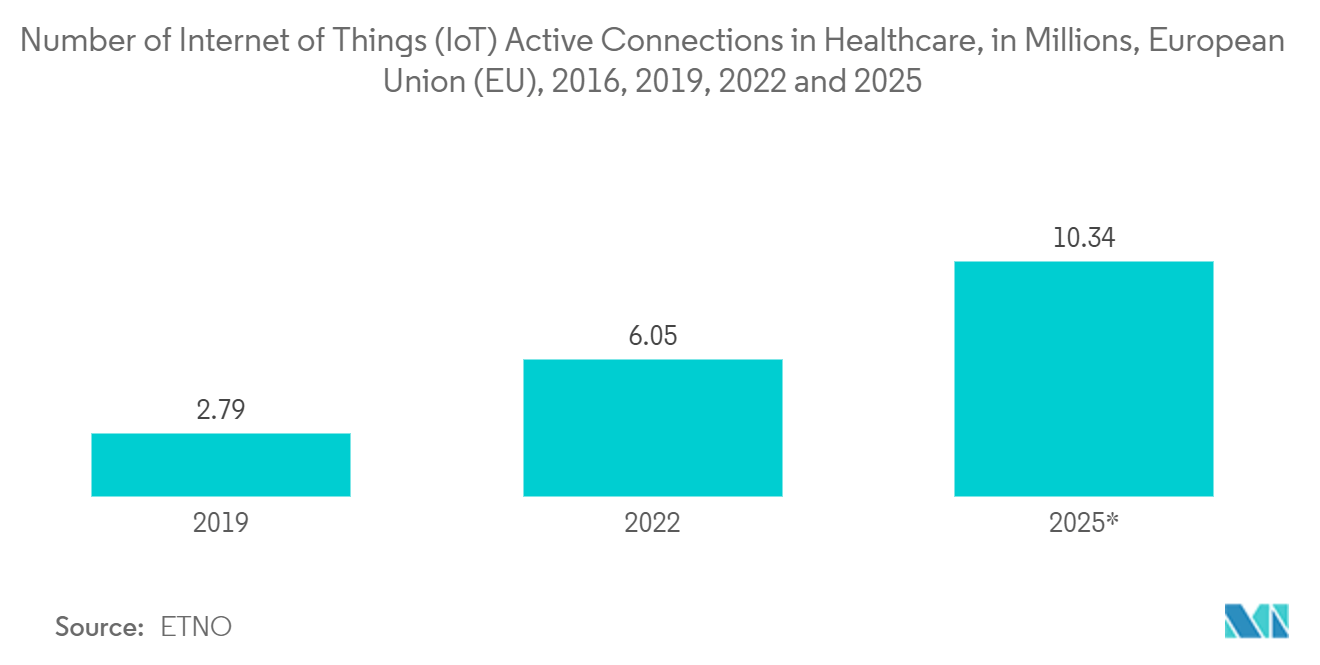
North America is Expected to Hold a Significant Market Share
- The North America region is expected to hold a significant market share owing to the technically advanced healthcare system, with prosperous economies, aging population segments, and advanced medical delivery systems. In addition, the growing healthcare expenditure coupled with increasing government initiatives to digitize the healthcare sector in the region are expected to drive the wireless healthcare market over the forecast period.
- Further, with an advanced primary medical community, extensive medical and life science research activities, high healthcare spending intensity, and large pharmaceutical and medical supply and device industries, the United States account for one of the world's largest markets for healthcare services.
- The North America region is home to some major market vendors operating in the wireless healthcare sector, thus driving the market rapidly. Further, digital transformation in healthcare had a rapid pace in recent years for offering connected patients, caregivers, and hospitals, primarily due to the focus on offering enhanced quality of care.
- Moreover, continuous advancements in wireless technology, such as WIFI 6 and WIFI 6E, are gaining significant traction from healthcare organizations in the region, thus positively impacting the market growth. For instance, North Carolina-headquartered Novant Health, a three-state integrated network of physician clinics, outpatient centers, and hospitals, recently announced the deployment of Extreme Networks' enterprise-grade Wi-Fi 6E solution. The Extreme AP4000 access point (AP) investment will enable the hospital to provide high-speed Wi-Fi throughout its facilities and allow dedicated, secure connectivity for mission-critical healthcare apps and medical devices.
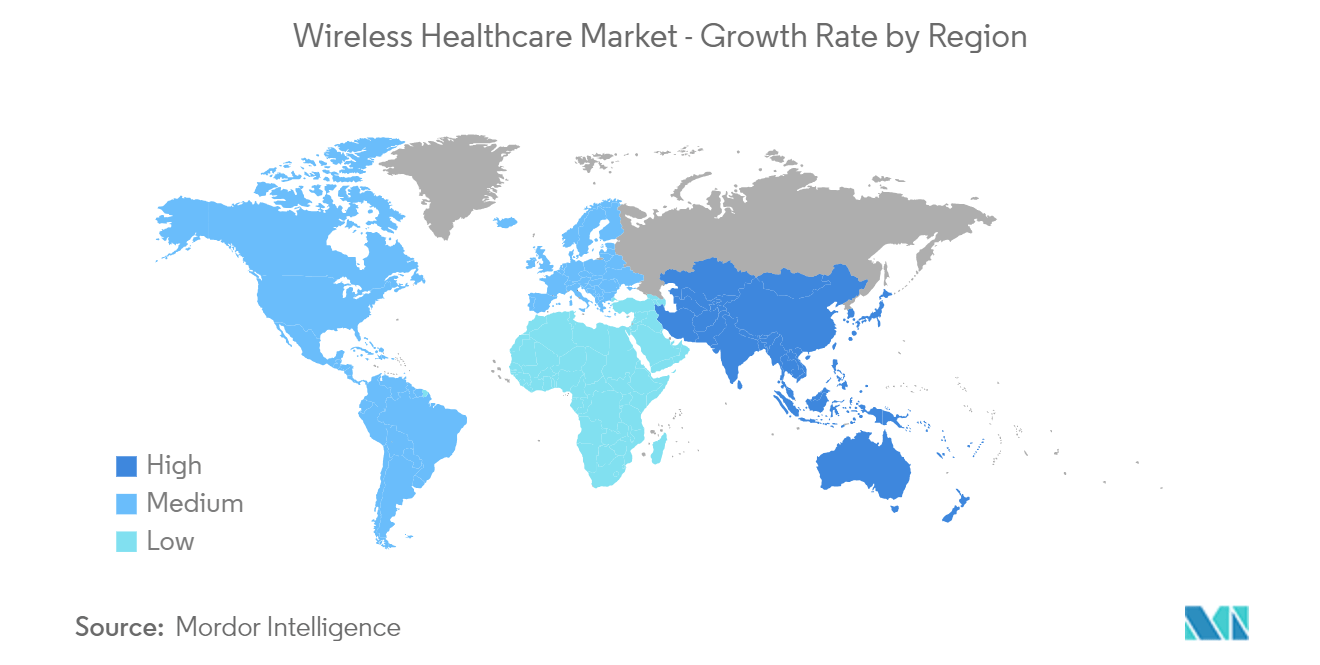
Wireless Healthcare Industry Overview
The wireless healthcare market is fragmented as the players strive to increase their market shares through strategies, such as improvements in the existing solutions and software platforms, the development of new platforms, and strategic alliances with other market players. Therefore, several players account for significant individual shares in the market. Key players include AT&T Inc., Cisco Systems Inc., and Motorola Solutions Inc.
In December 2023, AT&T’s has announced joining into smart healthcare is marked by its commitment to expanding high-speed internet and collaborating with the healthcare industry. By harnessing robust connectivity and advanced technology, Incorporating 5G into healthcare infrastructures markedly improves the speed and reliability with which these large imaging files are transmitted. This advancement plays a key role in enhancing the quality and accessibility of patient care.
In October 2023, Cisco and Bang & Olufsen today unveiled new true wireless earbuds built with enterprise-grade features customized for professionals on-the-go. This product release is an extension of the Cisco and Bang & Olufsen partnership, which addresses increased customer expectation for multifunctional devices that fit their lifestyles in and out of work.
In October 2022, Xenter announced the launch of XenFI, the first product in the company's wireless "Technology in Medicine" ecosystem, to improve the adoption of new technology in the healthcare sector. The newly launched product comprises XMD (a HIPAA-compliant, global healthcare cloud) and its XenFI-Hub, Xenter's wireless communications device designed for various healthcare settings. These first Xenter products are designed to enable smart/wireless devices, automate clinical workflow, improve patient outcomes, and lower healthcare costs.
In June 2022, GE Healthcare launched Portrait Mobile, a wireless patient monitoring system that continuously monitors a patient's stay. The wireless patient monitoring system helps clinicians detect patient deterioration. Portrait Mobile includes patient-worn wireless sensors which communicate with a mobile monitor.
Wireless Healthcare Market Leaders
-
AT&T Inc.
-
Cisco Systems Inc.
-
Motorola Solutions Inc.
-
Qualcomm Technologies, Inc.
-
Philips Healthcare (Koninklijke Philips N.V.)
- *Disclaimer: Major Players sorted in no particular order
Wireless Healthcare Market News
- April 2023 : Cherish and AT &T has announced that, when it ships to consumers in 2023, Serenity Cherish, a revolutionary sensing device that helps improve people's lives, will be equipped with AT&T cellular connectivity for immediate contactless connectivity. This cooperation will enable enterprise customers such as care homes, assisted living facilities and healthcare providers to benefit from this solution.
- March 2023: Amala Hospital launched a new, innovative smart ward with wearable wireless technology. The newly launched smart ward is equipped with advanced technology that offers continuous patient monitoring and aims at improving patient outcomes and reducing the risk of medical errors. The Amala hospital chain has collaborated with LifeSigns, a Chennai-based health-tech startup, to implement their iMS technology across medicine and cardiology departments at its hospital in Thrissur, Kerala.
- June 2022: NHS Digital announced to run off a series of trials to explore how wireless technologies can support better health and care delivery. The Wireless Centre of Excellence trials will enable NHS organizations to access funding for wireless technology that has the potential to improve connectivity in health and care settings.
Wireless Healthcare Industry Segmentation
The wireless healthcare market is growing, as the increase in the global geriatric population level is leading to a rise in the number of patients visiting hospitals. The aforementioned factor is also the root cause of the demand for integrated and connected solutions in hospitals, nursing homes, and home care centers.
The wireless healthcare market is segmented by technology (wireless personal area network (WPAN), Wi-Fi, worldwide interoperability for microwave access (WiMAX), and wireless wide area network (WWAN)), component (hardware, software, and services), application (hospitals and nursing homes, home care, and pharmaceuticals), and geography (North America, Europe, Asia Pacific, Latin America, Middle East & Africa). The market sizes and forecasts are provided in terms of value (USD) for all the above segments.
| Technology | Wireless Personal Area Network (WPAN) |
| Wi-Fi | |
| Worldwide Interoperability for Microwave Access (WiMAX) | |
| Wireless Wide Area Network (WWAN) | |
| Component | Hardware |
| Software | |
| Services | |
| Application | Hospitals and Nursing Homes |
| Home Care | |
| Pharmaceuticals | |
| Other Applications | |
| Geography | North America |
| Europe | |
| Asia-Pacific | |
| Latin America | |
| Middle East & Africa |
Wireless Healthcare Market Research FAQs
How big is the Wireless Healthcare Market?
The Wireless Healthcare Market size is expected to reach USD 197.19 billion in 2025 and grow at a CAGR of 19.95% to reach USD 489.64 billion by 2030.
What is the current Wireless Healthcare Market size?
In 2025, the Wireless Healthcare Market size is expected to reach USD 197.19 billion.
Who are the key players in Wireless Healthcare Market?
AT&T Inc., Cisco Systems Inc., Motorola Solutions Inc., Qualcomm Technologies, Inc. and Philips Healthcare (Koninklijke Philips N.V.) are the major companies operating in the Wireless Healthcare Market.
Which is the fastest growing region in Wireless Healthcare Market?
Asia-Pacific is estimated to grow at the highest CAGR over the forecast period (2025-2030).
Which region has the biggest share in Wireless Healthcare Market?
In 2025, the North America accounts for the largest market share in Wireless Healthcare Market.
What years does this Wireless Healthcare Market cover, and what was the market size in 2024?
In 2024, the Wireless Healthcare Market size was estimated at USD 157.85 billion. The report covers the Wireless Healthcare Market historical market size for years: 2019, 2020, 2021, 2022, 2023 and 2024. The report also forecasts the Wireless Healthcare Market size for years: 2025, 2026, 2027, 2028, 2029 and 2030.
Our Best Selling Reports
Wireless Healthcare Industry Report
Statistics for the 2025 Wireless Healthcare market share, size and revenue growth rate, created by Mordor Intelligence™ Industry Reports. Wireless Healthcare analysis includes a market forecast outlook for 2025 to 2030 and historical overview. Get a sample of this industry analysis as a free report PDF download.

